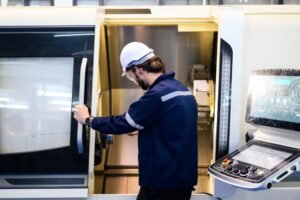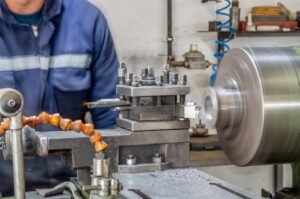Swiss machining often carries an air of mystery. Many manufacturers know the term but confuse it with conventional CNC turning. This guide clears up the misconceptions. By addressing common questions, debunking myths, and showing where Swiss machining excels, we’ll help you decide if it deserves a place in your production lineup.
What Makes Swiss Machining Unique?
Origins and Evolution: Why “Swiss”?
The term “Swiss” comes from the late 19th century, when Swiss watchmakers needed machines capable of producing microscopic yet flawless gears and screws. The principles behind those early screw machines—supporting the workpiece as close as possible to the cutting tool—still define modern Swiss-type CNC lathes. The historical background clarifies why Swiss machining is equated with extreme miniaturization and accuracy.
Core Features: Sliding Headstock, Guide Bushing, Sub-Spindle
Swiss machines stand apart from conventional CNC lathes because of three design features:
- Sliding headstock: Instead of tools moving toward the bar stock, the bar stock itself slides through the spindle. This minimizes deflection on long or thin parts.
- Guide bushing: Positioned right at the cutting zone, it supports the workpiece, allowing the machine to produce parts ten or twenty times longer than their diameter without bending.
- Sub-spindle: A secondary spindle grabs the part so operations can be completed on both ends in a single cycle. This eliminates secondary setups and boosts throughput.
Together, these features explain why Swiss lathes handle parts that would otherwise chatter, warp, or require multiple machines.
Precision and Tolerances
It is standard for Swiss-type machines to maintain tolerances within ±0.0002 inches (±5 microns). That’s thinner than a strand of hair. In sectors such as aerospace and medical manufacturing, this level of accuracy is indispensable. Bone screws, endoscopic tools, and fuel injectors are all real-world examples that showcase this repeatability. In fact, an orthopedic supplier reported a 99.8% dimensional conformity rate on 100,000 bone screws—saving inspection time and avoiding costly rework.
Frequently Asked Questions
- Is Swiss machining just CNC turning?
Not exactly. Both processes rotate bar stock and use cutting tools, but Swiss machining is defined by its sliding headstock and guide bushing design. This allows for long, slender parts with tight tolerances that a standard CNC lathe would struggle to produce.
- Is setup time always long?
Older mechanical Swiss screw machines did have lengthy changeovers—sometimes hours. But modern Swiss CNCs with modular tooling, presetters, and software-driven programming now allow changeovers in under an hour. A shop that once avoided small-batch runs now reports quoting jobs of 200 parts or fewer profitably.
- Do I need expensive CAD/CAM software?
Not always. CAD/CAM helps with highly complex parts, but many Swiss machines include conversational programming and cycle templates for common features. For instance, operators can program simple pins or shafts directly at the machine, saving software costs for routine work.
- Must I use ground bar stock?
Ground bar stock guarantees roundness and surface finish, which reduces vibration and tool wear. That said, for components with more lenient tolerance requirements, cold-drawn bar stock is often effectively utilized. The choice often comes down to balancing material cost vs. scrap risk.
- Is the machine hard to learn?
Swiss machining involves simultaneous axes, live tooling, and sub-spindle coordination, so the learning curve is steeper than a standard lathe. But modern controls simplify programming, and training programs shorten the path. A case study from a Midwest job shop showed operators reaching <2% scrap rates within six weeks of focused Swiss training.
- Do I need a highly trained operator onsite?
For highly complex medical or aerospace jobs, yes. But many shops cross-train existing CNC operators. With strong vendor support, Swiss machining doesn’t require a “guru” to be profitable—it requires disciplined training and process control.
- Can Swiss machining lower expenses and accelerate product development cycles?
Yes, especially in medium-to-high volume runs of small, complex parts. By eliminating multiple setups, Swiss machining reduces handling, scrap, and secondary processes. A manufacturer of dental implants cut lead times by 30% by consolidating three operations into one Swiss cycle.
Key Benefits in Practice
- Precision & Repeatability
The combination of the guide bushing and moving headstock ensures exceptional uniformity and repeatability. A medical supplier achieved near-perfect conformity in a 100,000-part run of bone screws, avoiding costly inspection bottlenecks and rework.
- Efficiency & Automation
Swiss machines integrate well with bar feeders, allowing “lights-out” production. One operator can manage several machines simultaneously—lowering labor costs and boosting spindle utilization.
- Material Flexibility & Broad Applications
Swiss machining supports a wide variety of materials, including stainless steel, titanium, brass, engineered plastics, and advanced alloys like Inconel. This technology is used to produce precision parts like medical implants, aircraft fittings, optical communication connectors, and fluid control valves.
- ROI in High-Volume Production
The upfront investment for a Swiss machine can exceed $250,000. But when parts require multiple features, Swiss machines replace several operations with one. An electronics supplier recovered its $300,000 investment in just 18 months by consolidating turning, milling, and drilling on a single machine.
Practical Tips to Evaluate Swiss Machining
- Part size and length: Swiss excels at long, thin, or deflection-prone parts.
- Volume: Medium-to-high production runs deliver the best ROI.
- Complexity: Parts needing multiple features on both ends are prime candidates.
Checklist for assessing suppliers:
- Do they have proven experience with similar parts?
- What tolerances can they hold consistently, not just occasionally?
- Can they provide samples or documented case studies?
- Do they run the materials you need (e.g., titanium, medical-grade plastics)?




